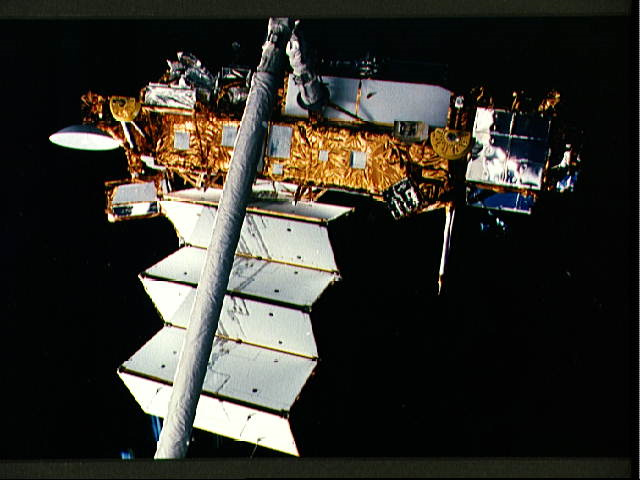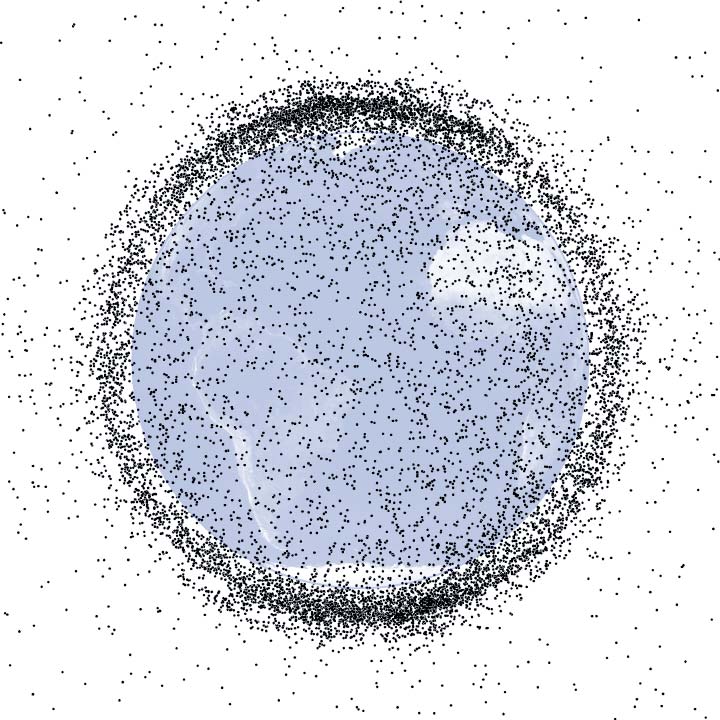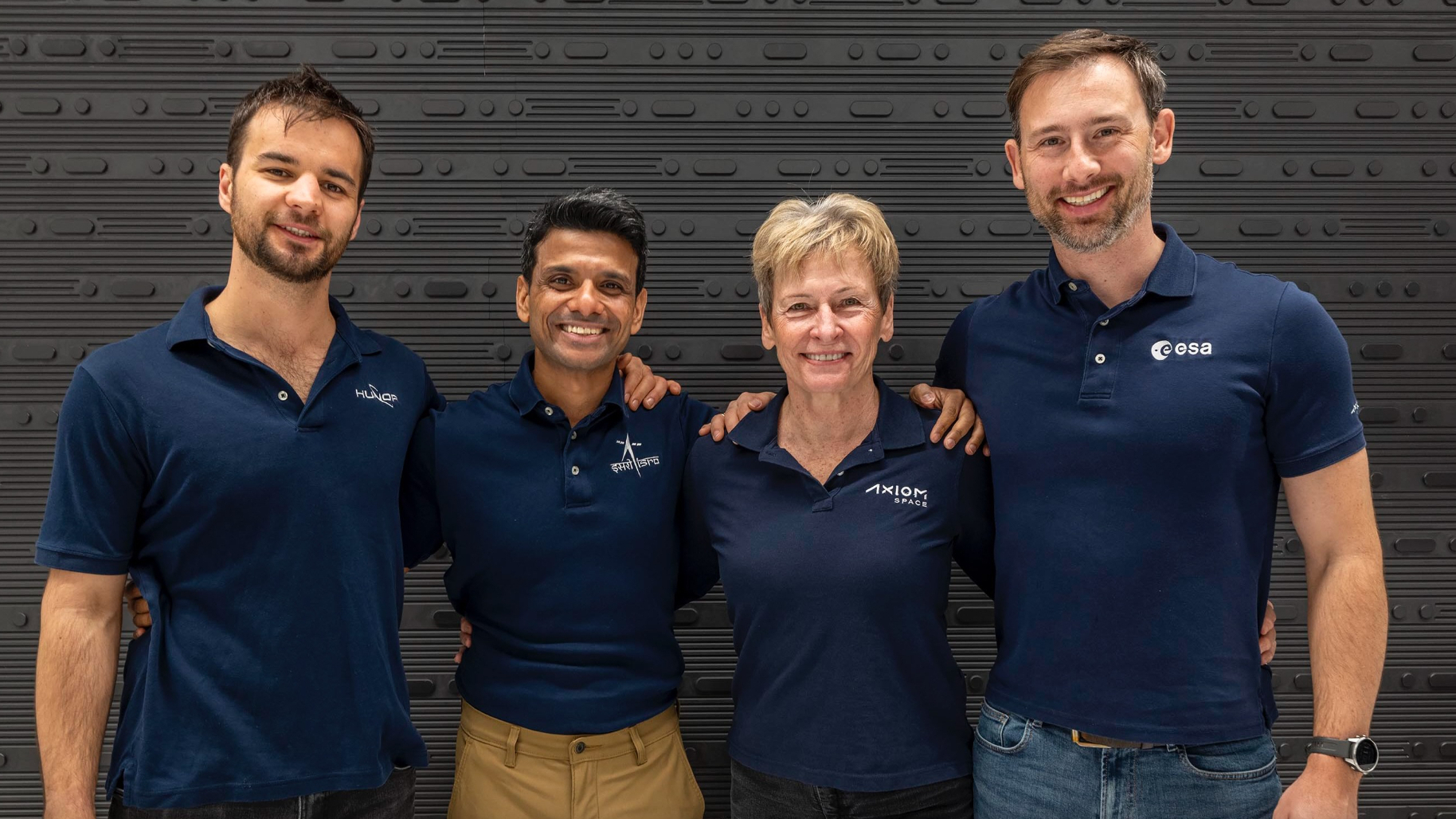Falling Satellites & Space Junk: Q&A with Orbital Debris Expert Ray Williamson

For the latest news about NASA's UARS spacecraft fall, visit: Falling NASA Satellite: Complete Coverage of UARS Spacecraft's Fiery Demise.
A defunct NASA climate satellite is tumbling back toward Earth, and will likely make its fiery plunge through the atmosphere tomorrow (Sept. 23), according to agency officials
The agency's Upper Atmosphere Research Satellite, or UARS, is expected to make landfall tomorrow, and while the threat of any debris falling over populated regions of the planet is very remote, the event has highlighted the ongoing issue of junk in space, and the need to promote sustainability and situational awareness in low-Earth orbit. Or at least orbital debris experts hope so.
With the 6.5-ton spacecraft expected to make landfall this week, SPACE.com caught up with Ray Williamson, executive director of the Secure World Foundation, an organization dedicated to the peaceful use of outer space, to talk about space debris, UARS, and why NASA can't just destroy the darn satellite before it falls to Earth. [Photos: Space Debris Images & Cleanup Concepts]
SPACE.com: This is not the first time that an old, out-of-commission satellite or piece of orbital debris has fallen to Earth. A 6.5-ton spacecraft is very large, but it's not unprecedented. Why do you think UARS has captured so much public interest?
Ray Williamson: I think because we're not used to these big satellites coming down. There are not that many, and whenever it occurs, it's always a good idea for NASA to let people know that it's happening. In this particular case, for example, there's not a whole lot to worry about, but it is worthwhile being aware that it's happening.
SPACE.com: In your experience at the Secure World Foundation, what similar events might you compare this to?
Breaking space news, the latest updates on rocket launches, skywatching events and more!
Williamson: There have been several. There was Skylab a long time ago. There was also the Russian Salyut spacecraft that came down. And, if I recall with Salyut, there wasn't a lot of control with that one. The issue is, NASA would like to have enough fuel left, but in the case of UARS, the fuel ran out several years ago, so slowly but surely it succumbed to solar pressure and the solar activity created enough drag that we're now seeing it tumble to Earth. [Photos of NASA's Huge Falling Satellite UARS]
SPACE.com: Why has it been so difficult for scientists to predict where pieces of the UARS satellite are going to land?
Williamson:There are a couple of things going on. One is the fact that the satellite itself is not a uniform structure; it's composed of different pieces that have been put together. It's partly a matter of not knowing enough. The shape of the structure is not perfectly spherical, so when it heats up and starts to break up, it will break into odd pieces. Once it begins to break up, then they can get a better sense of where this is roughly going to hit. [Related: Where On Earth Will NASA's Doomed Satellite Fall?]
What you'd see if you could see all this happening close-up, is the pieces slowly coming apart and a trail of light, because it's heating to the point where the aluminum structure melts. Also, it's coming into an atmosphere that is not uniform, so since we don't know precisely the structure of the atmosphere and what it's hitting, there will probably be uneven heating on the satellite.
Think about the pictures that you see — the artist's conception — of the Apollo capsule landing. If you remember seeing some of those, it was designed in such a way as to come into the atmosphere bottom first. There were ways to keep it on target as it came back, but you see this very uneven heating over the bottom of it.
SPACE.com: NASA has said repeatedly that there is very little chance that debris from UARS will fall on densely populated areas of the planet. But with all the unknowns that you mentioned, should people still be concerned?
Williamson: NASA and the Air Force — once it begins to break up — then they can get a sense of where this is roughly going to hit. If it comes over an ocean, in that case, we can sit back and watch the fiery re-entry. There could be a number of pieces that break apart and fall to the ground, but we're pretty small compared to the total land surface area of the Earth. There is so much open space and ocean that generally we don't have to worry very much about debris hitting a structure or a human. [Related: What Are the Odds You'll Get Struck by NASA's Falling Satellite?]
The story I like to compare it to is the breakup of Columbia. When [space shuttle Columbia] came back, as the shuttle heated up, it broke into pieces — some very large, and some very small. Even then, there was difficulty in trying to find the pieces that were spread over such a large area. It was such an unpopulated area that it was very difficult to locate all the pieces, even though they knew from videos pretty much precisely the track that it followed across the atmosphere.
SPACE.com: Is it feasible, or are there any benefits, to destroying the UARS satellite before it even enters Earth's atmosphere?
Williamson: People have raised that issue, but I don't think so. For one thing, it doesn't send a very good political message. How would you destroy it? Well, you'd do what the U.S. did with USA-193, which was a classified observation satellite. There, the stated public reason for destroying it with a missile was that the satellite had large amounts of what was, by that time, solid hydrazine. If that fell in a populated area, or even in an unpopulated area, it would be dangerous to people because it's highly toxic.
But there were people who also said this was an ASAT (anti-satellite weapon) test on U.S. terms done at a very low atmosphere, and frankly, I think they got enough negative feedback from other countries. You just illustrate to other countries who might want to demonstrate their ability to create an ASAT (anti-satellite weapons) in the guise of something else to demonstrate the technology. We want to stay away from that.

SPACE.com: Do you think the uncontrolled re-entry of UARS has highlighted, not just to members of the aerospace industry but also the public, the issue of orbital debris?
Williamson: I would hope so. It's a serious issue. I directed this project that did the first space debris study for the U.S. Congress. At that point, hardly anybody knew about space debris, and I thought it was very frustrating because I could see the way things were going. It turns out a decade or two later, the issue has become so concerning to people that they have begun to pay real attention to it. I think this re-entry will certainly cause a lot of interest in people. [Worst Space Debris Events of All Time]
SPACE.com: When did agencies and governments begin to realize that orbital debris had become a critical issue?
Williamson: I don't think you can point to one event, but if you wanted to, it would actually be two events that came fairly close to one another that caused people to think about it. The first one was the Chinese ASAT destruction of a satellite. By January 2007, when that took place, people in the industry and government who were space experts knew enough about debris and had it high enough in their thinking that they said, 'Hey, this is not only a wake-up call about a possible space weapon, it's also a wake-up call about additional pollution in space.' When Russia exploded some satellites in orbit, there wasn't that much appreciation of how that debris could grow.
The second dramatic event, of course, was the 2009 (February) event where the U.S. Iridium communications satellite and the Russian Cosmos satellite collided accidentally. That sort of woke people up, and the response has been pretty dramatic. For instance, the Air Force has put a lot more money into debris tracking because the idea that if we keep an eye on all the debris around working satellites, we can move a satellite if it looks like there's going to be an impact.
The other thing that's happened is there's been an awful lot of work done to mitigate the creation of debris during launch, so you don't add debris in space. And if you do, it's not as much as it would have been 10 years ago. There is a committee, called the Inter-Agency Space Debris Coordination Committee, that is composed of representatives from different space agencies around the world, and they've done a pretty good job. [Amateur Astronomer Photographs Doomed Satellite]
SPACE.com: The U.S. Air Force Space Surveillance Network keeps a pretty extensive catalog of orbital debris, so would you say we have a good handle of what's out there? Or is there more that we just don't know about yet?
Williamson: The Air Force tracks some 21,000 pieces of debris. The official catalog says there's about 16,000 pieces of debris where we can trace the origin. So, there's simply some that the people who follow this in NASA and Air Force haven't yet determined with a reasonable doubt where that debris comes from, so they won't put it in the catalog until then.
There are roughly 1,000 working satellites in orbit, and they follow all of these satellites as well as all the debris, so they can do what is called a conjunction analysis to see if any debris and a working satellite might collide. They can then try to predict ahead of time when that might happen and let the owners of the satellite know. This wasn't in place before the Iridium collision. Had this been done beforehand, that Iridium satellite could have been moved.
SPACE.com: Have we reached a tipping point with orbital debris?
Williamson: It's true that there are mitigation efforts, so if you only had additional debris from launches added to what is out there, you would see that it is leveling off. But then the problem comes with what is called fragmentations, because you've got different debris or different satellites, say, that might have a battery short after it's been up there for a long period of time, heats up, and explodes. Or, you could have an upper stage that was left in orbit after you launch a high-altitude communications satellite into orbit. In the past, companies left that upper stage up there and didn't worry about whether or not the fuel was gone from it. Now, what they do is vent the fuel from the system so that it can't eventually corrode and release fuel to cause an explosion. [Related: How Much Junk is in Space?]
SPACE.com: UARS was launched in 1991 before people were really concerned about space debris. Since then, what are some steps that are taken now to avoid having to deal with an uncontrolled re-entry of a satellite at the end of its life?
Williamson: The biggest one is to leave enough fuel in the structure to bring it back down in a controlled way. Basically, satellites don't fall down of their own volition. We say that in general speech, but they can't just fall down — they have to have some sort of pressure on them or force, and it has to do with drag. You have gravity always trying to keep it close to Earth, and then you have the velocity of the satellite always trying to go in a straight line. So, it's continually being bent back by gravity, but it's also being affected by the upper atmosphere. If you want to keep your satellite in orbit, you have to keep boosting it up with a little bit of fuel.
SPACE.com: There have been proposals submitted for different ways to clean up junk in space, but some seem like the stuff of science fiction. Have there been any proposals that have caught your eye that you think would be valuable to really consider?
Williamson: I haven't really seen one that I feel would fit the bill. I mean, frankly, any effort to remove debris from orbit always risks creating more debris than it cleans up. I haven't seen technology that would do the job in a way that would be responsible and cost-effective, and the biggest item is cost. Even if you created technology that is safe and can actually pull down some debris and make the situation better, you run into the problem that it's not cost-effective.
The one bright spot in that realm is that Intelsat, a few months ago, announced that it would enter into an arrangement with MDA of Canada to create an orbital servicing spacecraft that would go up to orbit and add fuel to satellites that are beginning to run out of fuel or do minor repairs, and that sort of thing. They seem to think that would be cost-effective over the long run, and if you did that, then you could find a very effective means, perhaps, for actually taking debris out of orbit. [Video: How the Refueling Satellite Will Work]
If you can add fuel to it and so forth, you can also perhaps clamp on a propulsion package to a dead satellite and send it to a higher orbit, which would effectively get it out of the way, and it would stay up there for many thousands of years. There are some technology people beginning to become really interested, but the cost issue is the real bear.
But, the other thing that one worries about at that point is if you create one heck of an anti-satellite device. It's dual use, so that's the third issue for me. Any time you can have a removal from orbit, you also run the risk of making an anti-satellite weapon, and then you have a hard time convincing people that it's legitimate.
Editor's note: If you snap a photo or observe the re-entry of NASA's UARS satellite and want to share it with SPACE.com for a story or gallery, contact managing editor Tariq Malik at: tmalik@space.com.
You can follow SPACE.com staff writer Denise Chow on Twitter @denisechow. Follow SPACE.com for the latest in space science and exploration news on Twitter @Spacedotcom and on Facebook.
Join our Space Forums to keep talking space on the latest missions, night sky and more! And if you have a news tip, correction or comment, let us know at: community@space.com.

Denise Chow is a former Space.com staff writer who then worked as assistant managing editor at Live Science before moving to NBC News as a science reporter, where she focuses on general science and climate change. She spent two years with Space.com, writing about rocket launches and covering NASA's final three space shuttle missions, before joining the Live Science team in 2013. A Canadian transplant, Denise has a bachelor's degree from the University of Toronto, and a master's degree in journalism from New York University. At NBC News, Denise covers general science and climate change.
